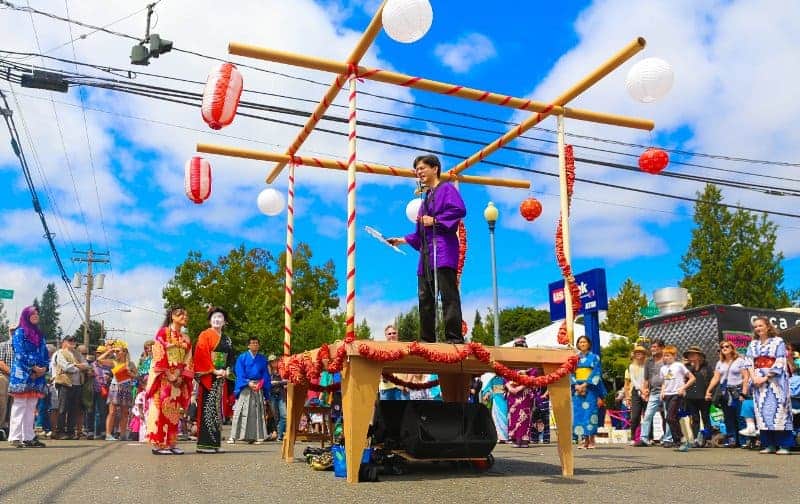
For the 2016 Strawberry Festival, Leah Mann, along with Friends of Mukai, the Vashon Chamber of Commerce, Vashon Center for the Arts, Chautauqua Elementary School, Vashon-Maury Land Trust, and 4Culture, organized a Bon Odori dance at the 2016 Strawberry Festival to honor Vashon’s Japanese-American past and to remember the internment of Japanese-Americans during World War II. To open the dance, she asked me to write and recite a poem.
You can read more about the event on the Vashon Beachcomber.
Opening Remarks
I’ll have to admit it is both wonderful and a bit strange to see a Bon Odori dance at the four-way stop here on Vashon. Growing up, I only really participated in O Bon, as we called it, on Maui, where my mother was born and raised, and where my mother’s family moved from Okinawa, now part of Japan. My memories of O Bon are of going with my Grandma and Grandpa, and my aunties and uncles, and my cousins and cousins and cousins and cousins, to a cemetery on the ocean just past the town of Paia, where my Great-Grandfather once had a barber shop. We’d go to the family tomb—the haka—hang paper lanterns, and honor our ancestors with incense, water, tea, food, and prayers. Then we’d dance in the Bon dance as the sun set into the sea.
I’ve brought a fan with me that my auntie used to use in dancing, in memory of those dances, and in honor of the continuing practice.
All of this could feel far away from Seattle, where I spent most of my childhood—with the exception of a few times and places. Like the days when our mother took us to Uwajimaya—the old one, with the blue tile roof—and I’d rush up to the gift shop to the explore the aisle with the origami paper, marveling at all the colors and kinds they carried.
In honor of that memory, I also brought a single crane, the first origami figure I learned to fold. It later became a poignant reminder for me of Sadako and the Thousand Paper Cranes, the story of a young girl who catches leukemia after the bombing of Hiroshima and decides to attempt folding a thousand paper cranes, believed to help a person to heal. Her plight and determination moved me as a child, and still do.
So these are the memories that were awakened in me as I composed this poem for our own Bon Odori here on Vashon. It’s called “Welcome to the Dance” and takes its form from the syllabic pattern of the Japanese waka, “short poem”: a 5-syllable line, followed by a 7-syllable line, followed by another 5-syllable line and two 7-syllable lines.
Welcome to the Dance
As children we danced
in the graveyards of Maui
my sister and I
having come from Seattle
the mainland visiting our
Grandma and Grandpa
Nakamura actually
Nakandakari
but changed like so many names
entering America
itself a name changed
crossing the wide sea and we
knew it as normal
as natural as breathing this
dancing with the living and
being with the dead
we do not dance for sadness
my grandfather said
but for joy like the daughter
who sees that her mother now
dances in the dance
beyond life and death—it seemed
so far from our home
in Seattle where I read
the story of Sadako
and her cranes struck down
before reaching one thousand
by the terrible
bright light of Hiroshima
turned to cancer in her veins
how can we dance I
wanted to know when the world
has known such horrors
bombings displacements and im-
prisonments of whole peoples
in the places they’d
come to call home I had no
answer and I have
no answer save the answer
that dances in the dancing
itself—we dance
because we can because we
have it in our bones
because all of our sorrows
are all of our joys hidden
in the dance between
the living and the dying
and the being here
together welcoming all
things and people and feelings
like Sadako whose
cranes are ours to keep folding
one thousand little
lights that together are not
little like the lanterns at
O Bon glowing in
the darkness gracing the tombs
of the dead who are
living—here in our hearts here
in our dance here in our lives
lighting the crossroads
lifting to the sky like birds
and their wings dancing
for joy and sorrow alike
for all that the dancing brings